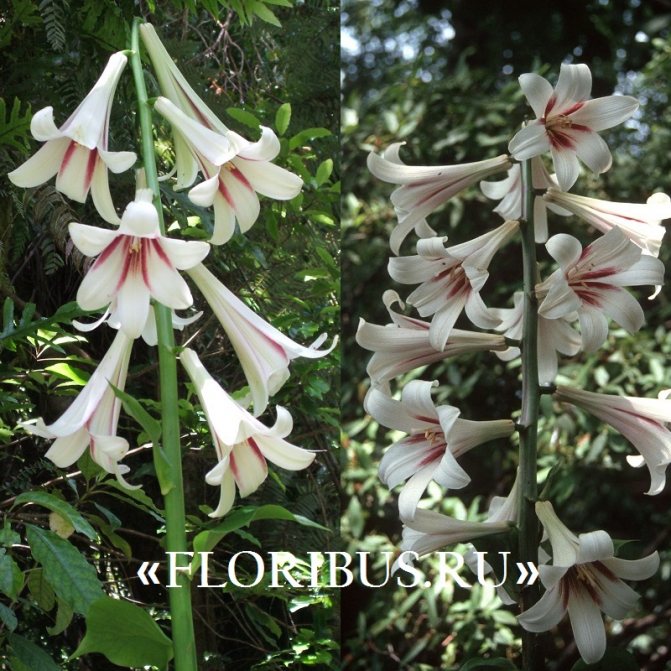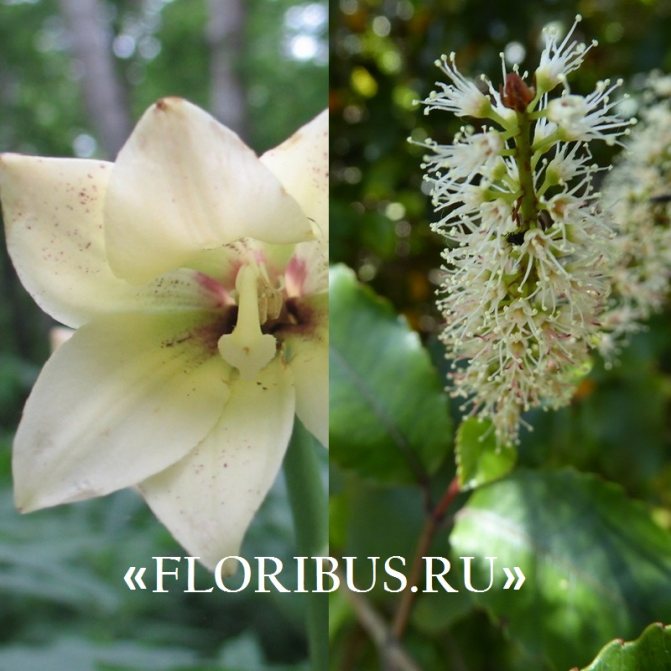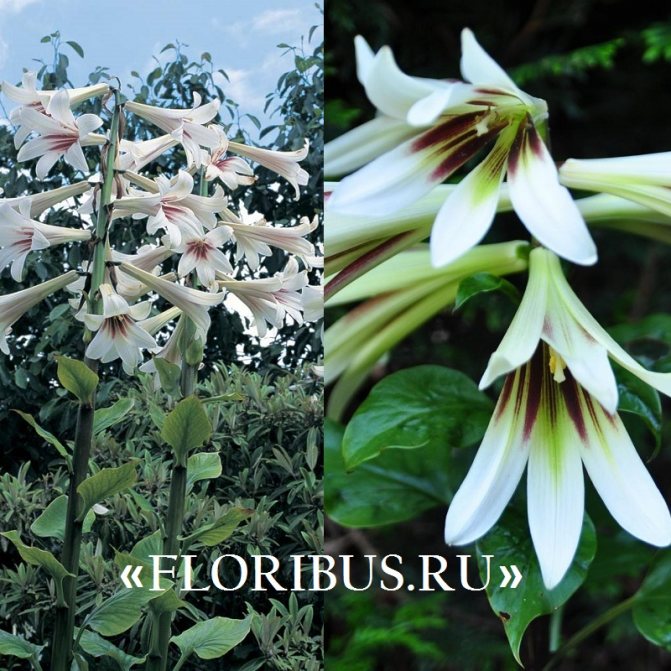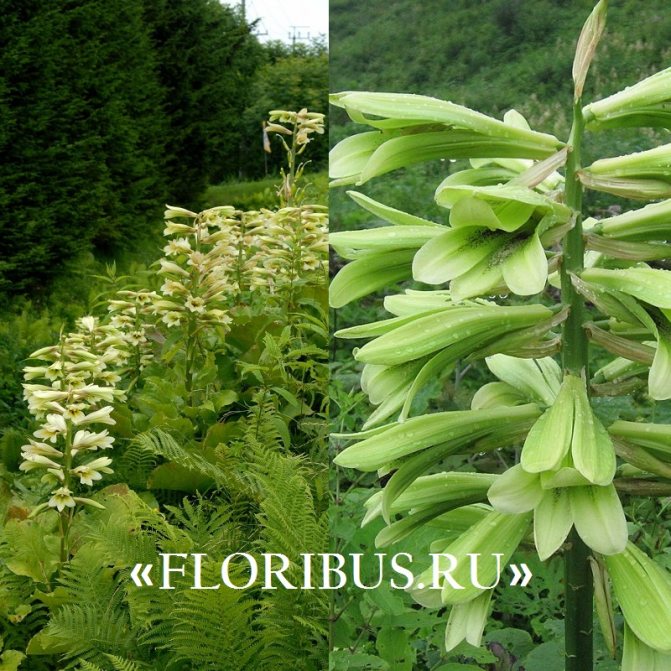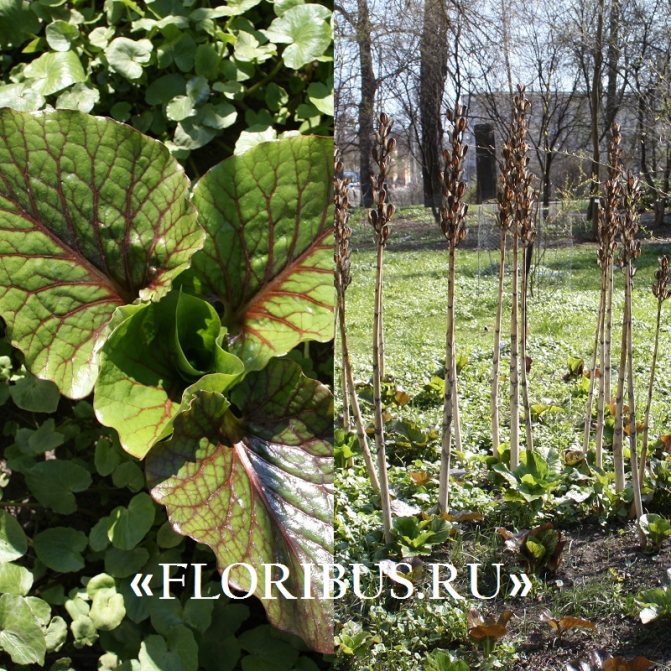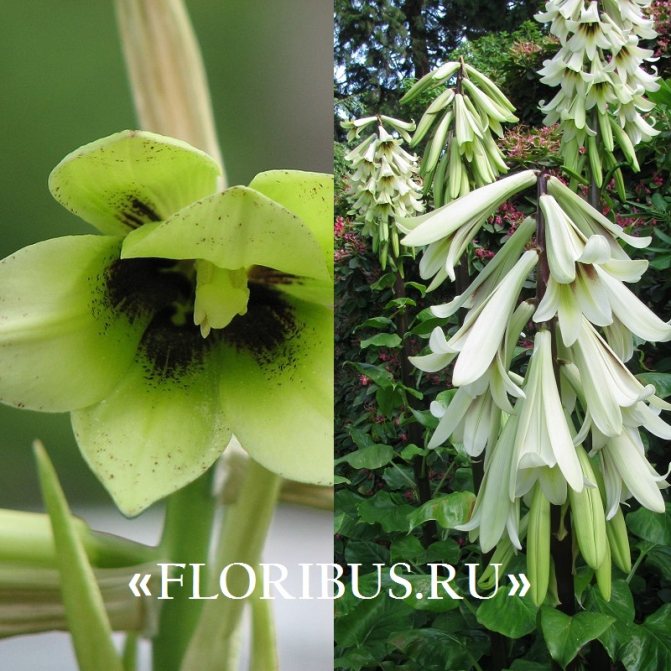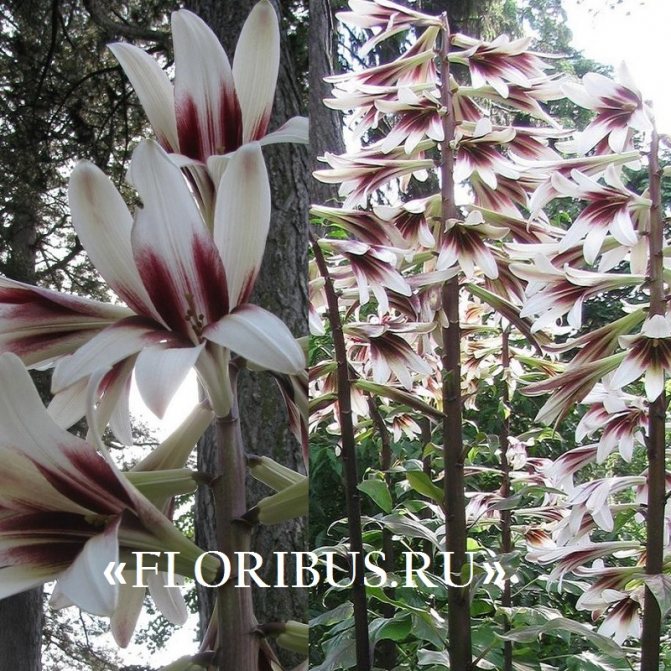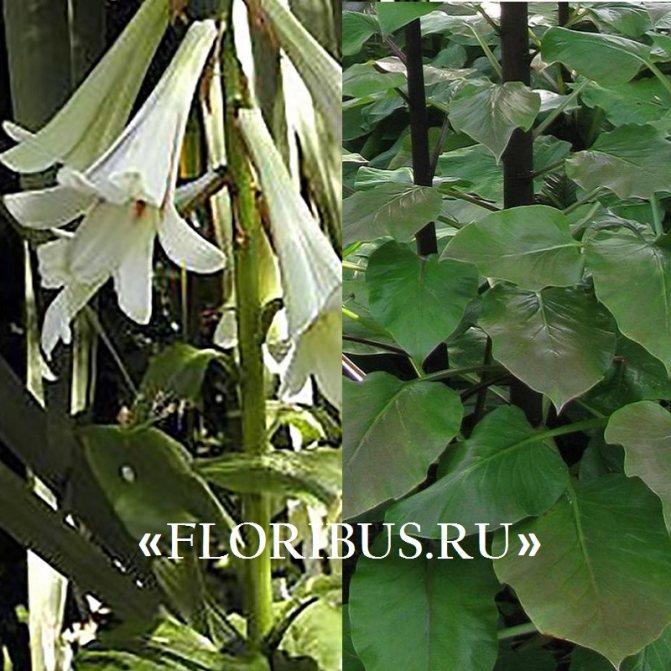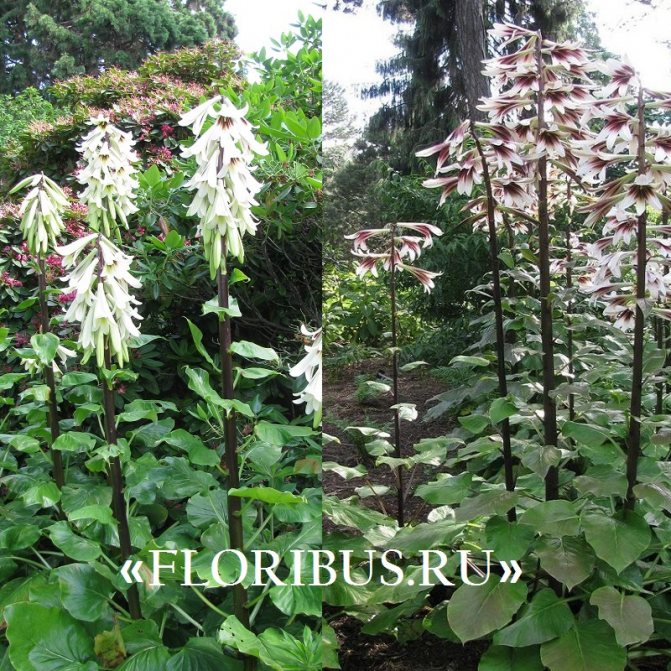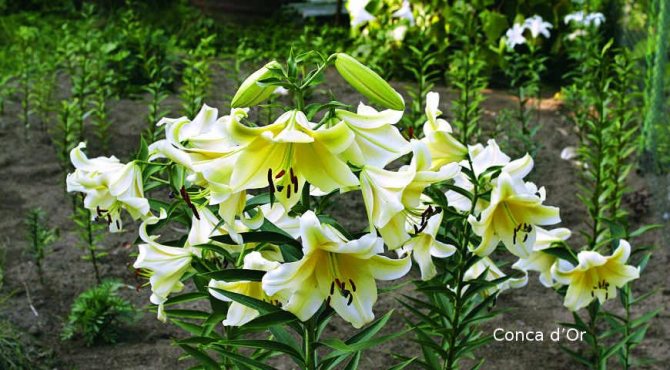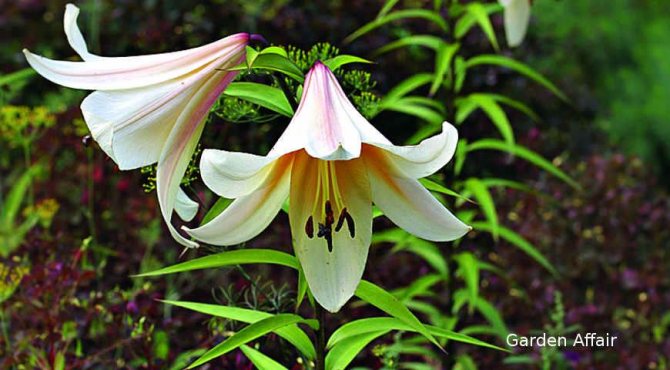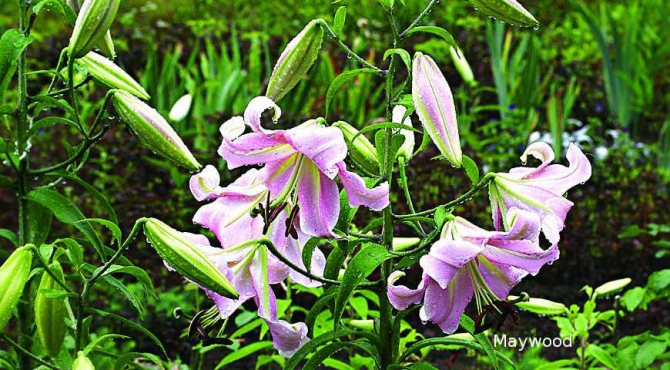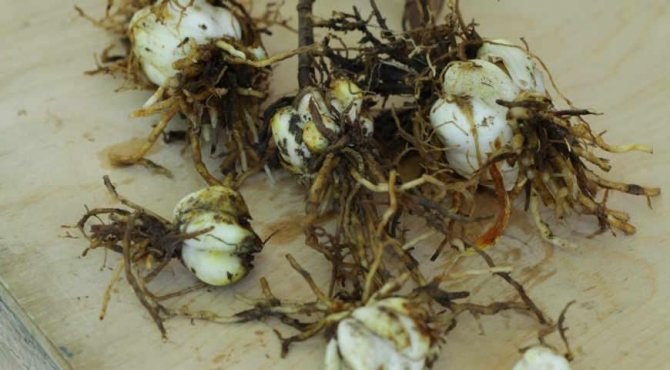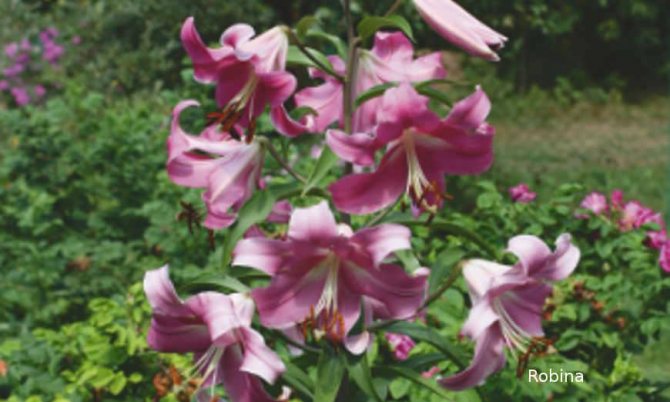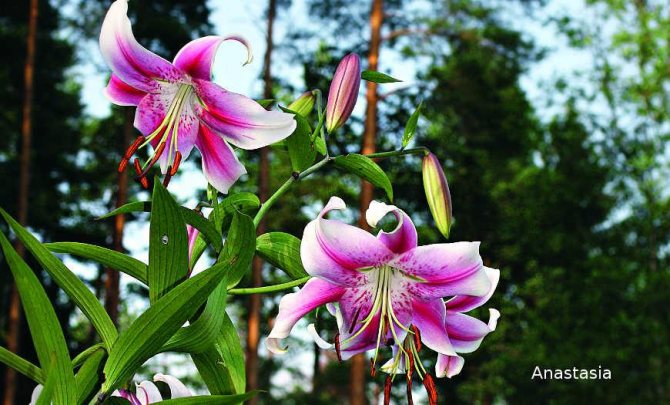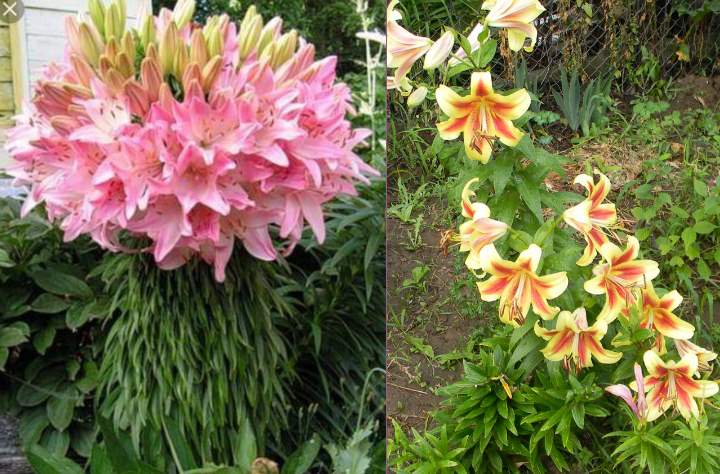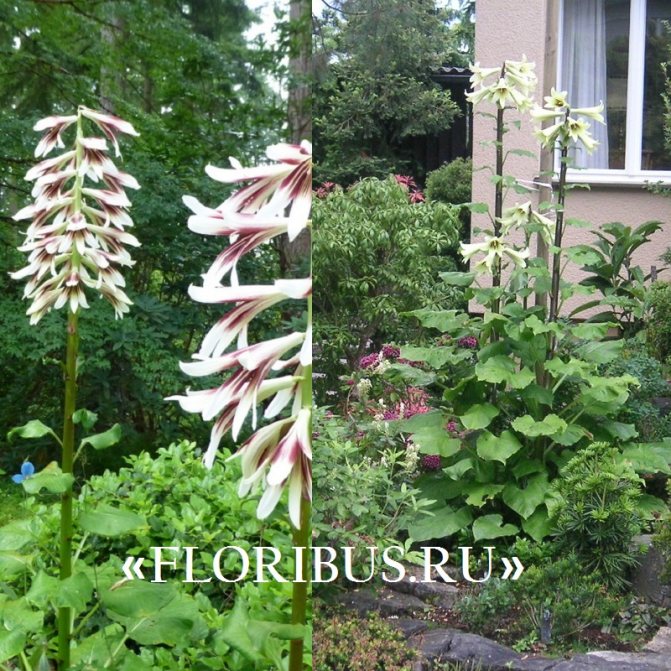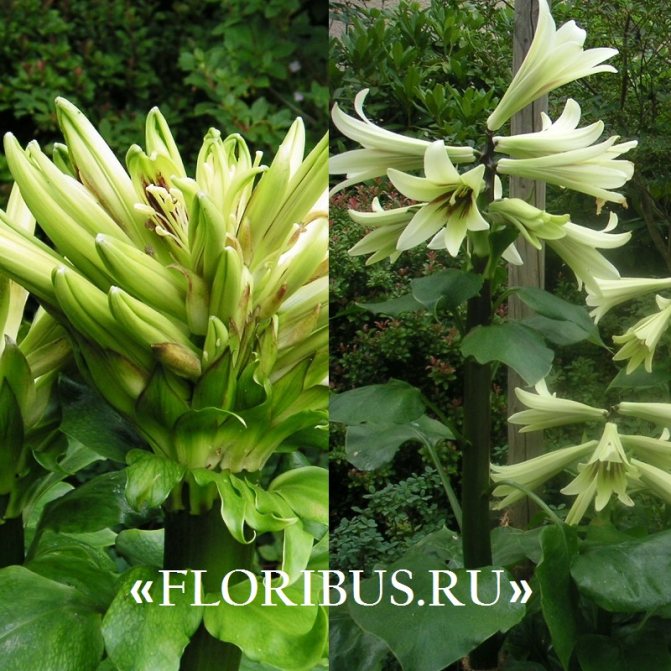Almost every florist grows lilies in the garden. They all belong to perennial bulbous plants. lily family.
In natural nature, there are several types of them, on the basis of which many hybrids and new varieties have been bred.
This flower grows everywhere, it can be found in Asia, Europe, North America. Translated from ancient Gaul, it means a white flower, however, in natural conditions, there are other shades of flowers of this perennial plant.
Many legends are associated with this flower, it is often used in heraldry, people write about it and compose poems. For Christians, a white lily means the symbol of the Mother of God.
Botanical features
Breeding achievements in our country and abroad have made it possible to breed very interesting tall varieties and hybrid forms of lilies, the height of which reaches two meters. Tall lilies have a scientific name - Lilium OT-hybrid or OT-hybrids.
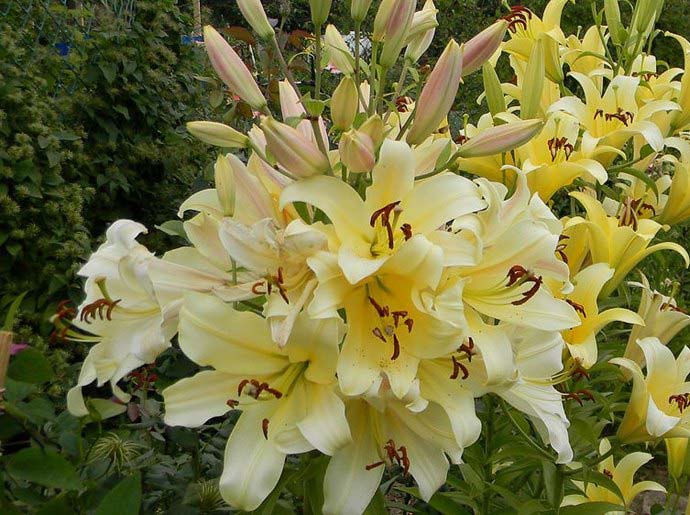
OT-hybrid forms of lilies or Orienpets are one of the most modern groups of this decorative culture of complex hybrid origin. Plants are characterized by the presence of strong and strong, vigorous shoots. The flowers are large. Their form can be:
- wide cupped;
- funnel-shaped;
- turbid.
All flowers grow upward or sideways. The color of the petals can be different. Moderate aroma, not very pronounced.
OT hybrids are characterized by high disease resistance and a decent level of winter hardiness. Most varieties can be grown not only as ornamental garden plants, but also for cutting and use in floristry.
Description of the plant
The varietal variety of lilies strikes the most daring imagination. Flowers differ not only in color, but also in size, shape of inflorescences and their location on the stem.
- Plant bulbs can be spherical and ovoid, they consist of numerous scales.
- The stem or trunk can be low (no more than 15 cm) and simply gigantic, reaching 2.5 meters
- The leaves are arranged on the stem alternately or in pairs; in some hybrids, a spiral arrangement of leaves is observed. They have an oblong or elongated shape with a sharp tip, but there are cylindrical, umbellate and conical leaves.
- Inflorescences of varieties also differ in many parameters and shapes, sometimes up to 20 or more flowers can be counted on one plant: funnel-shaped, tubular, cupped or flat.
- Shades of inflorescences can be found very different, the only thing that does not happen in nature is blue lilies.
- After flowering, in place of the bowls, fruits are formed in the form of long bolls, in which the seeds are located.
The best varieties
In our country, several unpretentious OT-hybrids have proven themselves well, which are obtained as a result of the work on crossing the oriental (Oriental) varieties with tubular (Trumpet) varieties.
| Variety name | Plant height | Description of flowers | Scent | Bloom |
| "Satisfaction" or "Satisfaction" | About 180 cm | Diameter 20-22 cm, very intense reddish-crimson color with a thin white border and yellow throat | Pleasant and unobtrusive | From mid-July |
| "Anastasia" or "Anastasia" | 120-190 cm | The petals are folded back, with a pink inner part, white edges and a whitish-green throat | Spicy and tender | At the beginning and middle of the last summer month |
| "Donato" or "Danato" | 140-205 cm | Curled petals, purplish-red, with purple edges and a yellowish-white throat | Pronounced | From mid-summer, relatively long |
| "Conca d'Or" or "Conca dior" | 180-240 cm | The petals are bright greenish-yellow on the inside. Border and upper part of the petals of a pale yellow-green color, the same coloration of the throat | Pronounced | Since the last decade of July |
| "Robina" or "Rabin" | 1.5-1.7 m | Curved petals, purple-red, with a yellowish-white throat | Well noticeable, pleasant aroma | From mid-July |
| Sheherazade or "Scheherazade" | Up to 2.5-2.7 m | Flowers drooping, dark red coloration | Pleasant and unobtrusive | At the beginning and middle of the last summer month |
| Black Beauty or "Black Beauty" | up to 200 cm | The flowers are turban-shaped, cherry-colored, have a greenish spot at the base and a white edging | Well noticeable, pleasant aroma | From mid-July |
Outright fraud
But in these photos, any specialist familiar with Photoshop will see a primitive overlay of pictures. Or "sleight of hand - and no fraud": just 8-10 stems of flowering lilies are tightly tied into one bunch and "planted" on a flower bed for a beautiful photo. And if you look closely - behind the usual forget-me-not, taller than, "2 meter lilies", and you never see the place from which this lily grows.
For especially distrustful buyers, the seller went to the next level - an album was shown, where some enthusiastic gardeners were already photoshopped to these lilies.
And also - copies of certificates were shown, where beautiful names were written and these varieties were described in some language (+ a photocopy of the translation into Russian with a hundred errors) against the background of some kind of print. If the buyer was very literate, they simply sent him away and threatened to call the police.
At the same time, the Internet was flooded with "reviews" of the happy owners of these lilies, where many famous flower growers unexpectedly "found" themselves in their garden embracing the same plants. Moreover, it reached the point of absurdity - the male head was attached to the female body.
Those who bought these truly "precious" bulbs, planted them in the best place in the garden, surrounded them with care and attention, in the end were at least deeply disappointed - ordinary lilies grew, a little larger in size and almost all of them had one pale pink in color. If the next year it was possible to catch the same sellers who were already selling either wisteria of all colors of the rainbow, or multi-colored liverwort for the same price, they began to load, they say, you provided the wrong care for your tree lily - so it “degenerated”. Or the planting was wrong - what did you grow there? Well, yes, it was it that ruined everything - it was impossible to plant next to it.
In short, you realized that no tree lilies exist in nature.
Landing rules
OT-hybrid forms of lilies are able to develop well and bloom profusely if the following conditions are met:
- planting is recommended to be carried out on sufficiently high flower beds, having previously equipped with high-quality drainage;
- the soil on the site must be sufficiently loose, with a sufficient content of coarse sand;
- when planting in areas represented by too heavy soils, sand must be added before planting the bulbs;
- for growing varieties of lilies of this group, well-lit areas with some shading for the lower part of the plants should be allocated;
- lily bulbs prepared for planting should be planted with a depth of 15-20 cm and a distance of 30-35 cm;
- planting is best done in late April or early May, as well as from September to early October.
OT hybrids do not need replanting for five years. It should be noted that the formation and formation of children in the tree lily is not active enough, therefore, with the vegetative method of reproduction, some difficulties may arise.
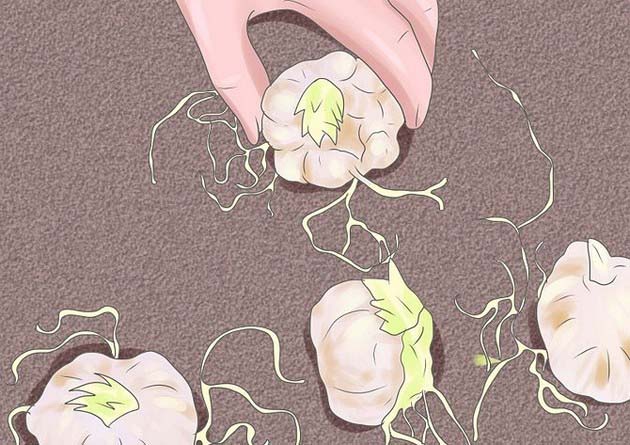

Reproduction of tree lilies
Plant bulbs are the most commonly used material. This breeding method is both simple and effective. With the help of scales from the bulb, plants can also be propagated, but this will take much longer and require patience from the grower. Planting bulbs and scales is usually done in the spring, when the soil warms up well. Adult bulbs are usually planted immediately on a place prepared in the garden, but the scales are first placed in a "kindergarten", in the form of a separate box, and only after the roots and sprout appear, they are transplanted to the flower bed.


Care features
The care measures for OT-hybrids of lilies are basically the same as for their "parents" - varieties of oriental lilies more familiar to flower growers:
- in dry and hot periods, lilies should be watered quite abundantly, especially in July, when the growth of the root system and flowering shoots is observed;
- when grown on the territory of the Moscow region from mid-September until the onset of stable frosts, it is advisable to cover the planting of lilies with garden plastic wrap;
- to ensure correct wintering of OT-hybrid forms of lilies, you should carefully monitor the soil moisture in the autumn period;


- in order to obtain full flowering from the moment of leaf blooming to the phase of active flowering, approximately three to four additional fertilizing with mineral complexes should be carried out;
- it is not recommended to use manure and compost as fertilizers, which can cause fungal infections of plants;
- in the Central Black Earth Region and more southern regions, in order to protect the bulbs from overheating, it is advisable to mulch plantings.
For the winter period, flower beds with lilies are recommended to be covered with coniferous litter. It should be noted that of all flowering ornamental plants, Oriental hybrids or Orienpet hybrids look best next to peonies that bloom before lilies and have lush foliage with high decorativeness.
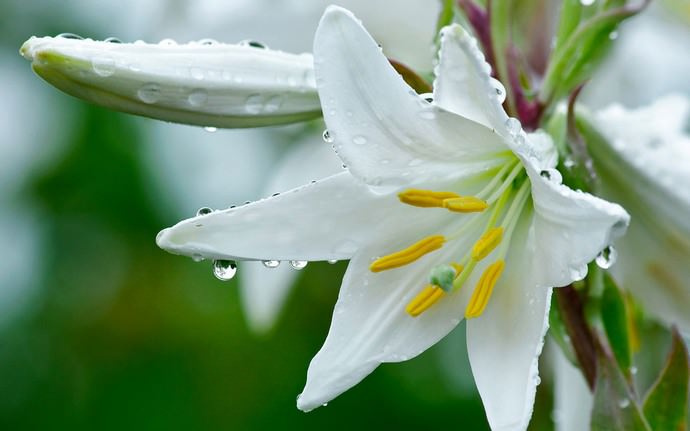

Plant diseases, prevention and treatment
Breeders began to breed such hybrids that are less likely to suffer from diseases than simple lilies.
Despite this, hybrids have the following diseases:
- Botrytis - in other words, gray rot is a fairly common disease. You can get sick with this in the spring, during the rainy season, when the ground is too wet. The disease manifests itself in the form of brown spots on the foliage. The plant can die within a few days. The disease can be cured by special preparations that should be sprayed onto the tree.
- Fungus. During transplanting or loosening, the bulb can be damaged and a fungus appears on it, which kills the plant. And the shoot itself with a damaged bulb will grow and even flowers will appear. Such a disease is called Fusarium. Before planting, the bulb should be carefully examined and left for half an hour in a special solution of the foundation.
- Blue rot appears on cunning, with improper storage. This disease manifests itself in the form of a green plaque. For prophylaxis and treatment, the bulb is left for half an hour in a solution of foundationol, and the soil around the planting site is watered with a special sulfur solution.
- Viral diseasesare considered the most dangerous for lilies and lily trees, such as:
- Tobacco mosaic;
- Cucumber mosaic;
- Variegated Virus.
These diseases cannot be cured, the plant is destroyed so that it cannot be passed on to future generations, it cannot be propagated. Viruses are carried by aphids, therefore, in order to protect lilies, preventive treatment for aphids should be carried out.
Reviews of the lily tree
According to amateur flower growers, the indisputable advantage of OT-hybrid forms of lilies is the formation of many large and fairly fragrant flowers on the stems. The varieties of this species grow well on acidic soils, therefore they are optimal for growing in the soil and climatic conditions of central Russia and the Moscow region. Moreover, As practice shows, OT-hybrid lilies are less susceptible to damage by diseases characteristic of lily cultures.
It is very important to remember that some unscrupulous sellers of OT-lilies can be marketed under the name "Lily tree", but the guarantee of getting a giant ornamental plant with hundreds of buds is nothing more than an advertising gimmick.
Is there a tree lily
Dear flower growers, the lily tree does not exist in nature. Probably someone once expressed his enthusiasm for the beauty and size of the hybrid, calling it a tree, but the story did not end there, but was overgrown with myths and riddles.
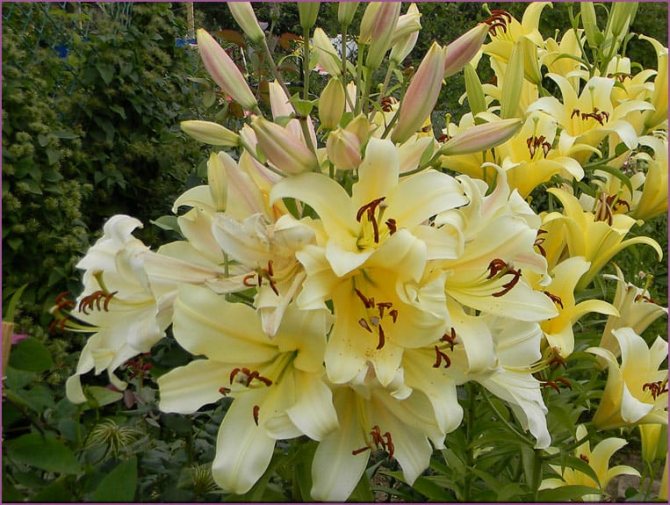

Most likely, a flower with an extremely high growth (more than 2.5 m) and a huge number of flowers was named a lily tree, but any gardener can achieve such parameters if you properly care for the lily, choose the desired variety and follow all the rules of agricultural technology.
It is these varieties, similar to real small trees, that were bred by Canadian breeders. These hybrids were distinguished by their incredible growth, strong aroma and size of flowers. But, do not forget that professionals in their field were engaged in breeding and growing these hybrids, and the plants themselves grew in ideal conditions for them, most likely in a greenhouse. It is quite difficult to grow such splendor, especially when the climatic conditions are far from normal.
Among the so-called "tree lilies" can be attributed to a tall hybrid called Goliath. Many scientists - botanists worked on its breeding, for many years they were able to improve the characteristics and consolidate the result on the example of several well-known hybrids:
- Anastasia is an OT hybrid with a stem height of two meters, it has a refined aroma and gorgeous flowers that are used for cutting.
- Scheherazade - can also be called a tree with flowers in the form of bowls that amaze with a variety of colors.
- Preti Vumen is an OT hybrid, tall and incredibly fragrant.
- You can name other hybrids that will also fit the parameters of the mythical lily tree known to us: Dona something, Purple Prince, Avocado and others.
All these representatives of the flower world are quite demanding on nutrition, watering and other activities that are included in the list of mandatory care. The soil in the area where you are going to plant the hybrid bulbs also plays an important role.
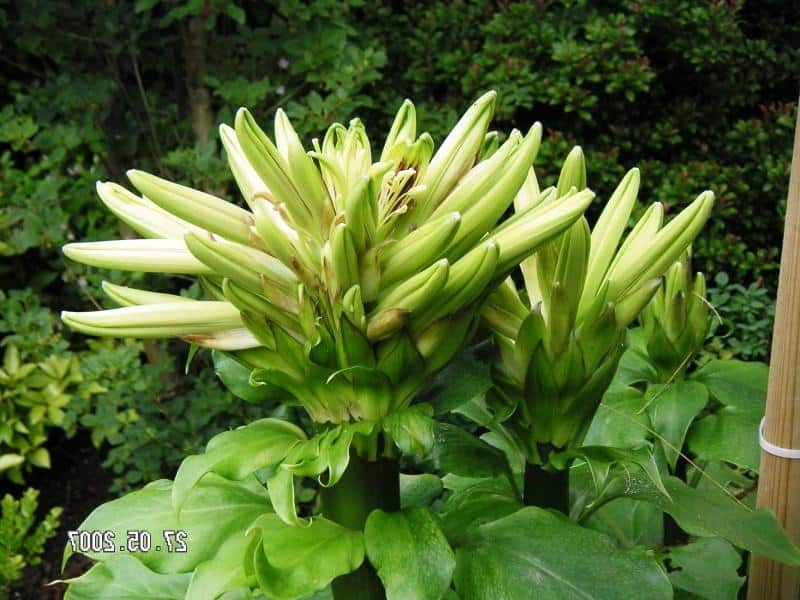

Beautiful anomaly
Everyone who saw blooming lilies did not remain indifferent to their royal splendor, a variety of colors. Asian hybrids, which are often classified as pyramidal, are of particular interest. This group has invaluable qualities: resistance to cold, early flowering, easy rooting. But lily lovers especially appreciate Asian hybrids for their enhanced shoot formation.
Nature knows an unusual phenomenon when several growth points are connected. Thus, individual stems grow together, the main one with lateral shoots. A wide ribbon-shaped peduncle with a ribbed surface is formed. An unprecedented number of buds are breaking through on it. The stem is often twisted and has unusual branching.The phenomenon has the Latin name fascial, which means a strip. Many people mistakenly consider this a feature of the new variety of lilies, they call them pyramidal.
Plants are striking with catchy beauty and uniqueness: a hundred flowers reveal all their splendor on a wide peduncle. The phenomenon is caused by the fact that several shoots arise from one bulb, which grow together into a peduncle. The multi-colored pyramid appears by chance and does not depend on the desire of the person. The next year, fasciation does not always appear, most often this phenomenon occurs with Marlene lilies.
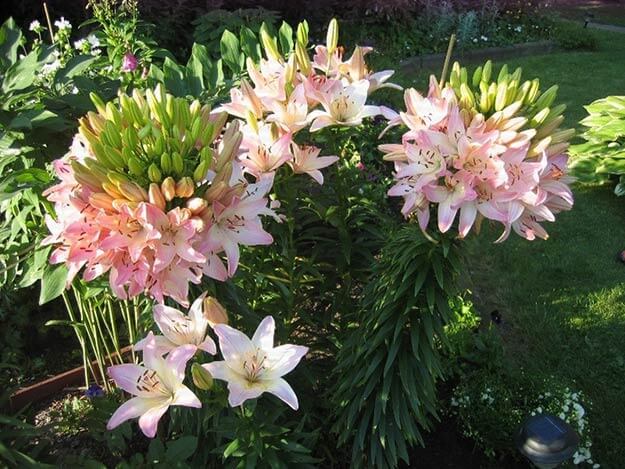

Types of cardiocrinum
Tall lily can be different, but there are three main types. They grow in the nature of Asia, in the mountains, grow them by gardeners and in their dachas. Each variety has its own characteristics - different heights, the arrangement of flowers - drooping or sticking out horizontally, the color - milky shades, pink, striped, light green.
Lily tree - the main species and their photos:
- Giant. This plant can be both medium-sized - 1.5 meters, and high - up to 4 meters. Lilies are very pleasant and smell strong, up to 80 of them can form on one peduncle, while the length of each flower is up to 20 cm. The species does not winter well in our climate, it needs shelter for the cold season. The flowers have reddish streaks;


- Glen. The second name of this species is heart-shaped. It can grow up to two meters, the peduncle is decorated with up to 35 lilies. They are less impressive than the first ones - up to 12 cm. The flowers have a delicate milky hue, there are dark burgundy stripes. The species also smells strong, blooms for a long time - a little less than a month. Occurs in the Kuril Islands and Sakhalin;
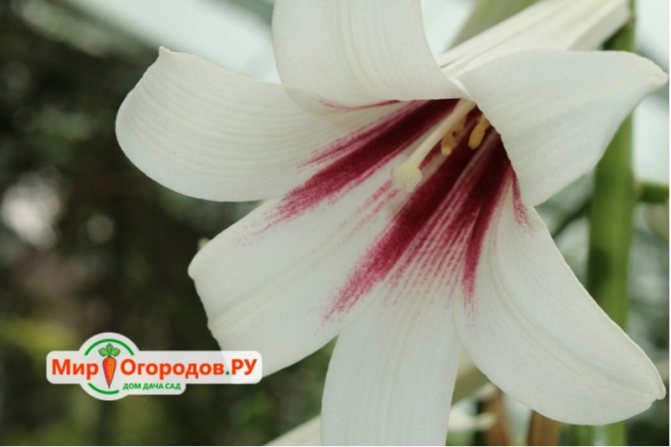

- Chinese. The smallest view is 1-1.5 meters on average. The peduncle forms no more than five lilies, there may be only one flower. This species is often grown in our southern regions. In temperate climates, you will need shelter for the winter, the bulbs are 5 cm in diameter.
Advice! Since the cardiocrinum is an impressive plant, it is better to plant it separately from the flower garden. It can decorate the lawn, grow next to trees, along the fence, as a hedge. Or combine flowers with hosts, geyhers.

